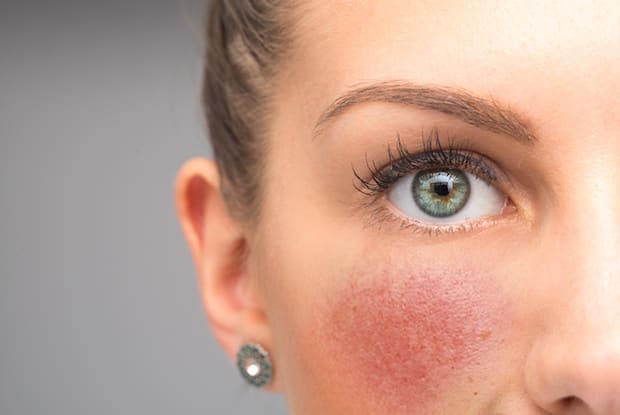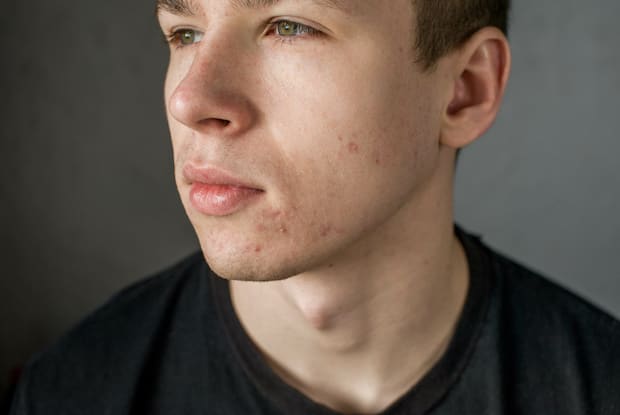Table of Contents
V. Shared psychological effects
VI. Treatments & preventative measures
Overview of rosacea
Rosacea is a common skin disorder that affects over 16 million people in the United States. Rosacea causes redness and visible blood vessels in the face. The symptoms of this condition may occur for weeks at a time or cause flare up due to external factors like stress. Rosacea can be mistaken for acne or natural ruddiness of the cheeks.
Rosacea can occur to men and women of all skin tones. There is no cure for rosacea, but many treatments like Azelex are available to keep symptoms under control. Rosacea is most common in women, but men who experience the condition may have more severe symptoms. The first large-scale survey of rosacea symptoms conducted by the National Rosacea Society showed that the disorder has some distinct differences in the pattern of symptoms in men and women. [1]

Symptoms
Facial redness is the most common symptom of rosacea, but several other conditions can also occur, varying in severity. The typical signs of rosacea in men and women can include:
Facial redness: The persistent redness is caused by a swelling of small blood vessels in your nose and cheeks, making the vessels visible on the face.
Enlarged nose (rhinophyma): Rosacea causes the thickening of the skin on the nose, which makes the nose appear bulbous.
Eye problems: Dry, irritated eyes, and swollen eyelids are a sign of ocular rosacea. These eye symptoms often precede any skin symptoms.
Swollen, red bumps: Acne-like pimples often accompany rosacea on the face. These pimples may sometimes contain pus and make your skin feel hot and tender. [2]
a. Differences in symptoms
There is an array of common rosacea symptoms, but some occur more prevalently in men over women and vice versa. Studies from the National Rosacea Society show that 49% of women experience rosacea symptoms on the chin, compared to 20% in men. Women also have more symptoms on their cheeks, with 87% affected compared to 68% in men. Symptoms may appear more severe in men, most often because men sometimes delay seeking medical help until the condition has reached advanced stages. [1]
Rhinophyma
An enlarged nose (rhinophyma) is one symptom that is much more dominant in men. In one study, 11% of the patients reported a form of rhinophyma, but men are twice as likely to suffer from this condition. A red and swollen nose can be unsightly and lead to rude assumptions.
It is a common myth that a red and puffy nose is the signal of a heavy drinker. The actor and comedian W.C. Fields perpetuated this myth by attributing his rhinophyma to excessive drinking. In fairness, alcohol can aggravate rosacea symptoms, but it does not cause rosacea.
Because men disproportionately experience rhinophyma, men often feel self-conscious about their ability to hide their reddened nose. Unlike women, men usually do not consider cosmetics to be an option. Men also have to deal with shaving their faces, which can further aggravate sensitive skin. It is recommended that men with this condition use an electric razor and test new shaving cream to make sure their skin reacts well. [3]
Hormone differences
The majority of rosacea cases occur between 30-60 years old for both men and women. The onset of this condition depends on the person, but studies show that many women with rosacea start experiencing symptoms during the beginning of menopause. The amount of estrogen in a woman’s body becomes unbalanced during menopause, which can cause a variety of symptoms including hot flashes, vaginal dryness, and mood changes.

Hot flashes occur because of imbalanced hormones affecting the body’s temperature control. Hot flashes are not only uncomfortable for menopausal women, but can aggravate or trigger the onset of rosacea. If you are experiencing menopause along with a rosacea flare-up, there are a few things you can do to reduce your symptoms:
- Exercise in cool temperatures
- Avoid hot or spicy foods
- Use sensitive skin products
- Always wear sunscreen (SPF of 15 or higher)
- If possible, skip hot baths and showers
- Keep stress to the minimum [4]
Shared psychological effects
Men and women may experience rosacea in differing severities, but every person with this condition can undergo unpleasant mental effects. In a National Rosacea Society survey of 1,000 patients, it was found that 60% of all respondents said rosacea negatively affected interactions in the workplace.
Both males and females report feeling depressed, embarrassed, anxious, and isolated due to their rosacea condition. Luckily, over 64% of these patients say that these feelings improved with proper treatment of their rosacea. [3]
If your rosacea is linked with anxiety, then embarrassment can exacerbate face-flushing, creating a vicious cycle. Those who feel stigmatized by their condition can lead to feelings of depression and isolation. Studies show that younger patients feel these effects more strongly than older patients. [4]

Treatments & preventative measures
The causes and symptoms of rosacea may differ in men and women, but the treatment methods can be used for everyone. Rosacea treatment can include medications as well as proper long-term skincare routines. Some following treatments may consist of:
Medications: Azelex is a conventional medication that contains azelaic acid. This drug promotes the body’s skin to renew itself and also helps reduce new pimples and blackheads. It can also eliminate the bacteria that can cause rosacea.
Regular cleansing: To prevent skin irritation, use only gentle measures to cleanse your skin. It is beneficial to use only lukewarm water and non-soap cleansers.
Proper products: A lot of skin products are too harsh for patients with rosacea, so astringents, exfoliating agents, and toners may cause further irritation.
Sun protection: It is essential to protect yourself from the sun’s rays when you have skin conditions like rosacea and acne. A silicone-based sunscreen of 30 SPF is recommended as well as protective clothing to shield your skin from the midday sun.
Makeup: Makeup may be used to cover up some redness and pimples that can accompany rosacea. Both men and women can use a green-tinted concealer or powder to reduce the redness. It is best to avoid oil products, alcohol, peppermint, menthol, clove oil, eucalyptus oil, and salicylic acid. [5]
The content in this article is intended for informational purposes only. This website does not provide medical advice. In all circumstances, you should always seek the advice of your physician and/or other qualified health professionals(s) for drug, medical condition, or treatment advice. The content provided on this website is not a substitute for professional medical advice, diagnosis or treatment.
